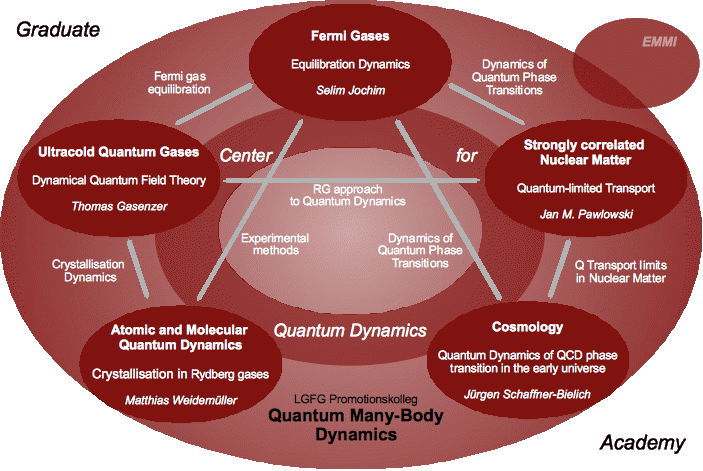Research Overview
Time evolution of many-body systems in which effects of quantum physics play an important role
belong to the least satisfactorily understood physical phenomena. Quantum effects prevent that the
time evolution can be described in a fully deterministic way and they make the problem to be mathematically
highly complex. Two main aspects make up the complexity connected with nonequilibrium
phenomena and their theoretical description: Long-time evolution and strong correlations.
These aspects occur in a wide range of different phenomena including the particular topics being
subject of this proposal and can not be considered independently from each other.
Due to the enormous progress in the field of ultracold atomic quantum gases, quantum many-body
dynamics can now be very precisely controlled and probed and become a timely topic for laboratory
studies. Moreover, new experiments in high-energy nuclear physics and advances in astronomic
observation technology have opened a wider field of dynamical many-body phenomena for empirical
investigation. On the theory side, the exponential growth of available computing power has
brought quantum dynamics of many-body systems into the reach of large-scale calculations while
sophisticated advanced analytical approaches open the way to a deeper understanding of quantum
many-body evolution.
The thus emerging topic forms the leading theme of the Promotionskolleg proposed here. The applicants
plan to take up a number of collaborations, in particular also between experiment and theory
to make use of potential synergies in Heidelberg and advance the understanding of special fundamental
questions arising in the context of quantum many-body nonequilibrium physics.
The specific topics to be studied include the equilibration dynamics of strongly correlated systems,
transport of such systems through quantumdots which act to some extent like the eye of a needle,
bounds on the viscosity of a quantum gas, mechanisms of the inflationary expansion of the early
universe, and the transition of a superfluid to a „supersolid“ by high excitation of the atoms.
The
graphical scheme shown below relates these research topics to the different member
groups of the Research Training group and highlights planned collaborations.






